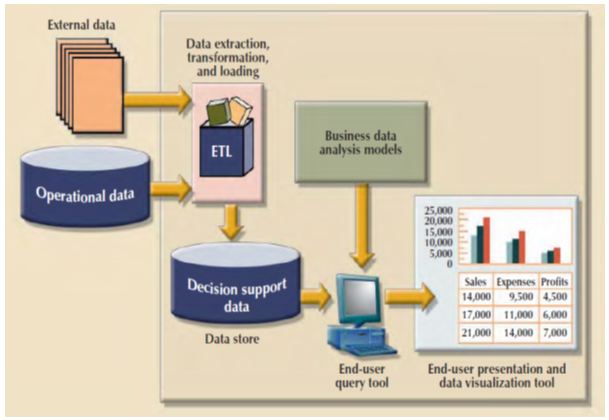Business Intelligence and Its Architecture
Business intelligence (BI)1 is a term used to describe a comprehensive, cohesive, and integrated set of tools and processes used to capture, collect, integrate, store, and analyze data with the purpose of generating and presenting information used to support business decision making.
BI is a framework that allows a business to transform data into information, information into knowledge, and knowledge into wisdom. Implementing BI in an organization involves capturing not only business data (internal and external) but also the metadata, or knowledge about the data. BI provides a well-orchestrated framework for the management of data that works across all levels of the organization. BI involves the following general steps:
Operational Data and Decision Support Data
The Data Warehouse and Data Mart
OLAP and Its Characteristics
Relational OLAP
• Collecting and storing operational data.
• Aggregating the operational data into decision support data.
• Analyzing decision support data to generate information.
• Presenting such information to the end user to support business decisions.
• Making business decisions, which in turn generate more data that is collected, stored, etc. (restarting the process).
• Monitoring results to evaluate outcomes of the business decisions (providing more data to be collected, stored, etc.).
Business Intelligence Architecture:
BI covers a range of technologies and applications to manage the entire data life cycle from acquisition to storage, transformation, integration, analysis, monitoring, presentation, and archiving. BI functionality ranges from simple data gathering and extraction to very complex data analysis and presentation. The BI architecture is composed of data, people, processes, technology, and the management of such components. The following figure depicts how all those components fit together within the BI framework.
The different components of BI frame work are as follows.
ETL tools:
Data extraction, transformation, and loading (ETL) tools collect, filter, integrate, and aggregate operational data to be saved into a data store optimized for decision support. For example, to determine the relative market share by selected product lines, you require data on competitors' products. Such data can be located in external databases provided by industry groups or by companies that market the data. As the name implies, this component extracts the data, filters the extracted data to select the relevant records, and packages the data in the right format to be added to the data store component.
Data store:
The data store is optimized for decision support and is generally represented by a data warehouse or a data mart. The data store contains two main types of data: business data and business model data. The business data are extracted from the operational database and from external data sources. The business data is stored in structures that are optimized for data analysis and query speed. The external data sources provide data that cannot be found within the company but that are relevant to the business, such as stock prices, market indicators, marketing information (such as demographics), and competitors’ data. Business models are generated by special algorithms that model the business to identify and enhance the understanding of business situations and problems.
Data query and analysis tools:
This component performs data retrieval, data analysis, and data-mining tasks using the data in the data store. This component is used by the data analyst to create the queries that access the database. Depending on the implementation, the query tool accesses either the operational database, or more commonly, the data store. This tool advises the user on which data to select and how to build a reliable business data model. This component is generally represented in the form of an OLAP tool.
Data presentation and visualization tools:
This component is in charge of presenting the data to the end user in a variety of ways. This component is used by the data analyst to organize and present the data. This tool helps the end user select the most appropriate presentation format, such as summary report, map, pie or bar graph, or mixed graphs. The query tool and the presentation tool are the front end to the BI environment.
Decision Support Data:
Although BI is used at strategic and tactical managerial levels within organizations, its effectiveness depends on the quality of data gathered at the operational level. The differences between operational data and decision support data are examined in the next section.
Star Schema and Its Components
Issues In Data Warehouse Implimentation


